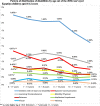A national screening for the prevalence and profile of disability types among Egyptian children aged 6-12 years: a community-based population study
- PMID: 37608272
- PMCID: PMC10463448
- DOI: 10.1186/s12889-023-16489-8
A national screening for the prevalence and profile of disability types among Egyptian children aged 6-12 years: a community-based population study
Abstract
Aim: This study aimed to determine the prevalence of disability domains among Egyptian children in the age group of 6-12 years as well as assess their socio-demographic, epidemiological, and perinatal predictors.
Methods: A national population-based cross-sectional household survey targeting 20,324 children from eight governorates was conducted. The screening questionnaire was derived from the WHO ten-question survey tool validated for the identification of disabilities.
Results: The prevalence of children with at least one type of disability was 9.2%. Learning/ comprehension was the most prevalent type (4.2%), followed by speech/communication (3.7%), physical/ mobility and seizures (2.2% for each), intellectual impairment (1.5%), visual (0.7%), and hearing (0.4%). The commonest predictors for disabilities were children who suffered from convulsions or cyanosis after birth and maternal history of any health problem during pregnancy. However, preterm and low birth weight (LBW) babies or being admitted to incubators for more than two days were strong predictors for all disabilities except hearing disability. A history of jaundice after birth significantly carried nearly twice the odds for seizures (AOR = 2.2, 95% CI:1.5-3.4). History of difficult labor was a predictor of intellectual impairment (AOR = 1.5, 95% CI:1.1-2.0). A disabled mother was a strong predictor for all disabilities except seizures, while a disabled father was a predictor for visual and learning/ comprehension disabilities (AOR = 3.9, 95% CI:2.2-7.1 & AOR = 1.6, 95% CI:1.1-2.4 respectively). Meanwhile, both higher maternal and paternal education decreased significantly the odds to have, physical/ mobility and Learning/ comprehension by at least 30%.
Conclusion: The study found a high prevalence of disability among Egyptian children aged 6-12 years. It spotted many modifiable determinants of disability domains. The practice of early screening for disability is encouraged to provide early interventions.
Keywords: Communication; Disability, School age children, Children Aged 6–12 Years, Vision; Hearing; Mobility—Intellectual impairment; Seizures; Speech.
© 2023. BioMed Central Ltd., part of Springer Nature.
Conflict of interest statement
All authors report no conflict of interest. “No financial or non-financial benefits have been received or will be received from any party related directly or indirectly to the subject of this manuscript.
Figures



References
-
- World Health Organization; World Bank . World Report on Disability. Geneva: World Health Organization; 2011.
-
- World Health Organization . WHO global disability action plan 2014–2021. Better health for all people with disability. 2015.
-
- Thompson S. Disability prevalence and trends. 2017.
Publication types
MeSH terms
LinkOut - more resources
Full Text Sources

